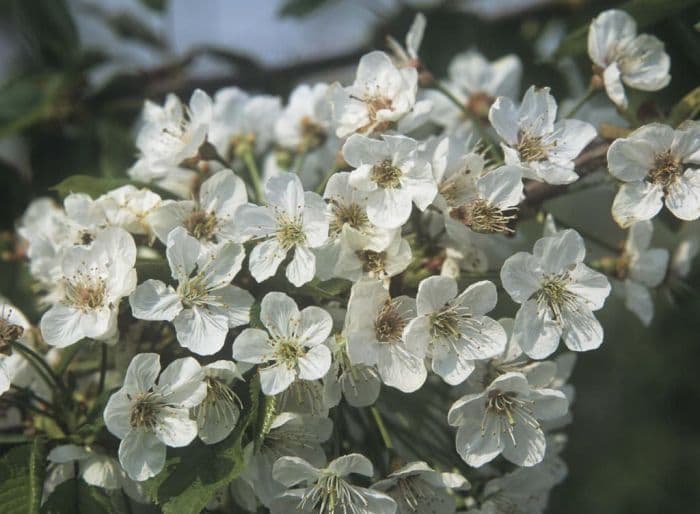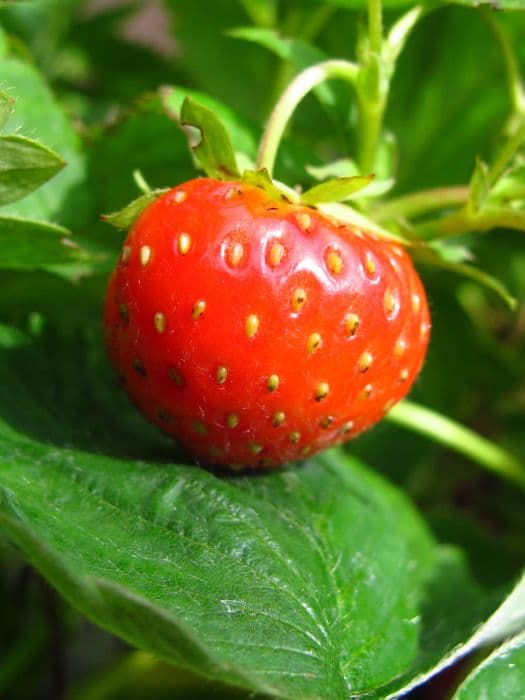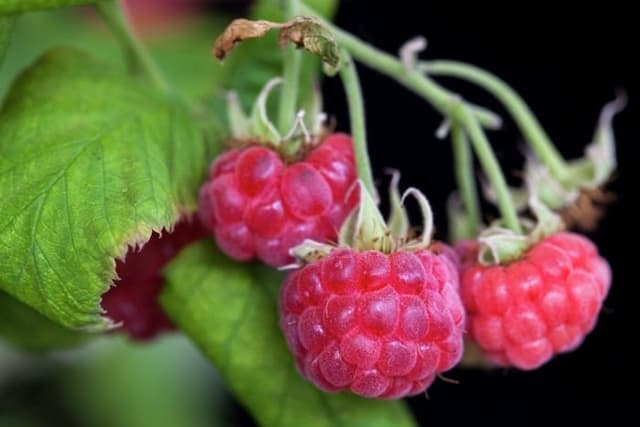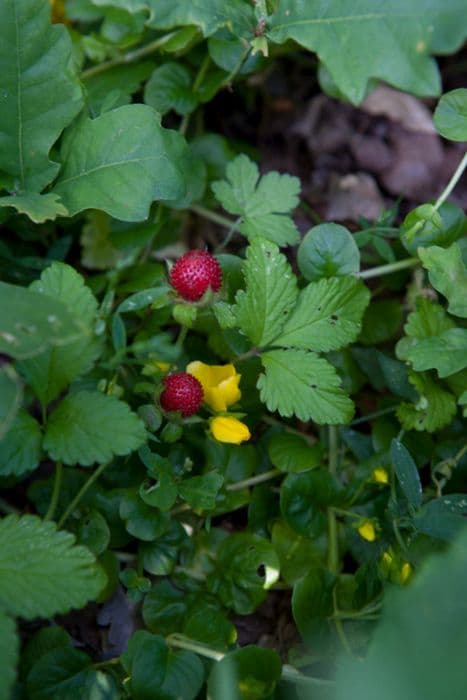Sweet cherry Prunus avium

ABOUT
Prunus avium, commonly known as the sweet cherry, is a deciduous tree that is known for its beautiful and distinct appearance. It dons a smooth, glossy bark that can range in color from reddish-brown to grayish, often with conspicuous horizontal lenticels that add textural interest to the trunk. In spring, the sweet cherry is adorned with clusters of white to pale pink flowers that blossom in profusion, creating a stunning floral display that can be quite an attraction for pollinators like bees. The leaves of the sweet cherry are simple and ovate with a finely serrated margin and a tapered point at the tip. They emerge as a fresh, glossy green and can change to a stunning array of yellows, oranges, and reds in the autumn, providing seasonal interest. The foliage arrangement is alternate, contributing to the overall open and airy canopy structure. After pollination, the sweet cherry produces fruit for which it is famously cultivated. The cherries have a stone inside, are round in shape, and have a shiny, smooth skin that can be red, yellow, or blackish-red when ripe. The fruit is known for its sweetness, juiciness, and is often enjoyed fresh, in baking, or preserved. The cherries dangle from the branches, tempting both humans and wildlife with their delicious taste. The overall appearance of the sweet cherry plant is one of elegance with its showy flowers, attractive foliage, and tempting fruits, which coupled with its smooth bark, makes it a favored ornamental and fruit tree in many gardens and orchards.
About this plant
 Names
NamesFamily
Rosaceae.
Synonyms
Sweet Cherry, Wild Cherry, Gean.
Common names
Cerasus avium (L.) Moench, Prunus cerasus var. avium (L.) Hook., Prunus cerasus subsp. avium (L.) Ehrh., Prunus juliana Lindl.
 Toxicity
ToxicityTo humans
The sweet cherry (Prunus avium) is generally not toxic to humans when consumed as the flesh of the fruit. However, the seeds, leaves, and stems contain compounds that can be toxic. They contain cyanogenic glycosides, which can release cyanide when ingested. It is rare for poisoning to occur because a significant amount of seeds, leaves, or stems would need to be chewed and ingested. Symptoms of cyanide poisoning include headache, dizziness, shortness of breath, and potentially fatal complications such as respiratory failure or cardiac arrest if consumed in very large quantities.
To pets
The sweet cherry (Prunus avium) can be toxic to pets, such as cats and dogs, if they consume parts of the plant other than the fruit flesh, particularly the seeds, leaves, or stems. These parts contain cyanogenic glycosides, which can be converted into cyanide, a toxic compound. Symptoms of cyanide poisoning in pets may include dilated pupils, difficulty breathing, panting, and shock. In severe cases, ingestion can lead to respiratory failure or even death. It is important to prevent pets from having access to the seeds, leaves, and stems of sweet cherry plants.
 Characteristics
CharacteristicsLife cycle
Perennials
Foliage type
Deciduous
Color of leaves
Green
Flower color
White
Height
32 feet (9.75 meters)
Spread
25 feet (7.62 meters)
Plant type
Tree
Hardiness zones
5
Native area
Europe
Benefits
 General Benefits
General Benefits- Nutritional Value: Prunus avium, commonly known as sweet cherry, is rich in vitamins, minerals, and dietary fiber.
- Dietary Antioxidants: Sweet cherries contain high levels of antioxidants which help in reducing oxidative stress.
- Low-Calorie Snack: They are low in calories and make for a healthy, sweet snack.
- Aesthetic Appeal: The sweet cherry tree provides aesthetic value with its beautiful blossoms during spring.
- Shade Provider: As a deciduous tree, it can provide shade and cooling effects in gardens and parks during the hot summer months.
- Wildlife Habitat: The sweet cherry tree serves as a food source and habitat for birds and other wildlife species.
- Economic Value: The fruit of the sweet cherry tree is commercially valuable and widely consumed fresh, dried, or in processed forms.
- Culinary Uses: The cherries can be used in a wide range of culinary dishes, from desserts and pastries to sauces and preserves.
 Medical Properties
Medical Properties- Antioxidant - The fruit of Prunus avium, commonly known as sweet cherry, contains antioxidants which may help protect cells from damage caused by free radicals.
- Anti-inflammatory - Sweet cherry has compounds that may possess anti-inflammatory properties, potentially beneficial in reducing inflammation.
- Anthocyanins Content - Sweet cherries are rich in anthocyanins, which may have health-promoting effects including potential benefits for heart health.
- Gout and Arthritis - Consumption of sweet cherries may be associated with reduced symptoms of gout and arthritis, although more research is needed for conclusive evidence.
- Sleep Aid - Sweet cherries contain melatonin, and consumption may help regulate sleep patterns.
- Muscle Recovery - Due to their anti-inflammatory properties, sweet cherries may aid in quicker recovery of muscle function post-exercise.
- Cancer Research - Compounds found in sweet cherries are being studied for their potential anti-cancer properties, though research is still preliminary.
- Cardiovascular Health - Ongoing research suggests that sweet cherries might support heart health by reducing risk factors such as cholesterol levels and blood pressure.
 Air-purifying Qualities
Air-purifying QualitiesThis plant is not specifically known for air purifying qualities.
 Other Uses
Other Uses- Woodworking: The wood from the sweet cherry tree is valued for its fine grain and is commonly used to make furniture, cabinets, and specialty wood items.
- Dye Production: The bark of the sweet cherry tree can be used to create plant-based dyes for textiles with varying shades depending on the mordant used.
- Ornamental Use: Sweet cherry trees are planted as ornamental trees in gardens and parks for their beautiful spring blossoms and attractive fall foliage.
- Wildlife Habitat: The sweet cherry tree provides shelter and nesting sites for birds and other wildlife within its branches.
- Edible Landscaping: Sweet cherry trees are often incorporated into edible landscaping schemes for their aesthetic appeal and fruit production.
- Culinary Wood Chips: Wood chips from the sweet cherry tree can be used for smoking meat and fish, imparting a mild, fruity flavor to the smoked food.
- Wood Turning: The wood of the sweet cherry tree is popular in woodturning for the production of decorative bowls, platters, and artisanal crafts.
- Natural Play Structures: Branches and trunks from the sweet cherry tree may be used in the creation of natural play structures and features in outdoor play areas.
- Photography: Sweet cherry tree orchards, particularly during blossom season, are sought-after locations for photography, including weddings and landscapes.
- Festivals and Cultural Events: Sweet cherry trees and their blossoms are celebrated in many cultures, with festivals dedicated to their blooming seasons that attract tourism and foster community activities.
Interesting Facts
 Feng Shui
Feng ShuiThe sweet cherry is not used in Feng Shui practice.
 Zodiac Sign Compitability
Zodiac Sign CompitabilityThe sweet cherry is not used in astrology practice.
 Plant Symbolism
Plant Symbolism- Sweetness and Innocence: The sweet flavor of Prunus avium, commonly known as the sweet cherry, symbolizes innocence and the simple joys of life.
- Love and Romance: Cherries are often associated with love and romance, reflecting their heart shape and rich, red color reminiscent of passion and desire.
- Youth and Vitality: The fleeting bloom of cherry blossoms represents the ephemeral nature of life, celebrating youth and the vitality of the moment.
- Beauty and Fragility: The delicate blossoms of the cherry tree symbolize beauty and how quickly it can fade, much like the fragile blooms that appear and disappear with the changing seasons.
- Renewal and New Beginnings: Cherry trees are amongst the first to bloom in the spring, making them symbols of renewal and the start of a new cycle of life.
- Education and Enlightenment: In some cultures, the cherry is a symbol of education and the pursuit of knowledge, as blooming cherry blossoms are associated with the time of the year when students embark on new academic endeavors.
 Water
WaterThe sweet cherry tree (Prunus avium) should be watered deeply, especially during its formative years to establish a strong root system. Generally, watering once a week with about 10-15 gallons per session is sufficient, but this can vary depending on climate conditions and soil type. During hot, dry periods, water the tree twice a week, ensuring moisture reaches 12-18 inches deep. In the fall and winter, reduce watering as the tree requires less. Always check the soil moisture before watering to prevent over-hydration, which can lead to root rot.
 Light
LightSweet cherry trees require full sunlight to thrive, ideally receiving at least six to eight hours of direct sunlight a day. Plant them in a spot that is not shaded by buildings or other trees to ensure they get adequate light for healthy growth and fruit production. These trees do best in regions with long, sunny days, which helps in the development of fruit sugars.
 Temperature
TemperatureSweet cherry trees prefer temperate climates with cold winters and warm summers. They can withstand winter temperatures as low as 20°F, but temperatures below this can damage the tree. The ideal growing temperature for sweet cherry trees is between 75°F and 85°F during the growing season. They do require some winter chilling, at least 1200 hours at temperatures below 45°F, to ensure proper flowering and fruit set in the spring.
 Pruning
PruningPrunus avium, commonly known as the sweet cherry tree, requires pruning to maintain its shape, remove dead or diseased wood, and encourage fruit production. Prune during the dormant season, late winter to early spring, before new growth begins. Aim to open up the canopy for better light penetration and air circulation. Thin out some of the old wood to ensure that the tree continues to produce vigorous new growth and healthy fruit.
 Cleaning
CleaningAs needed
 Soil
SoilSweet cherry trees (Prunus avium) thrive in deep, well-draining loam with a pH of 6.0 to 7.0. A mix of loam, compost, and sand in equal parts creates an ideal growing medium that retains moisture while allowing excess water to drain, preventing root rot.
 Repotting
RepottingSweet cherry trees typically do not require frequent repotting and are often planted directly in the ground. However, if grown in containers, they should be repotted every 3 to 5 years to refresh the soil and provide room for root growth.
 Humidity & Misting
Humidity & MistingSweet cherry trees, being outdoor plants, do not require a specific humidity level. They are adaptable to the common humidity ranges found in temperate climates where they naturally grow.
 Suitable locations
Suitable locationsIndoor
Sweet cherries can't grow indoors; they need full sun outdoors.
Outdoor
Plant sweet cherries in full sun, well-draining soil, space 35ft.
Hardiness zone
5-9 USDA
 Life cycle
Life cyclePrunus avium, commonly known as the sweet cherry, begins its life cycle when a seed is planted in the soil and undergoes germination, typically in the spring. The seedling emerges and develops into a juvenile tree, going through a phase of vegetative growth where it establishes its root system and begins to sprout leaves and branches. After several years, the juvenile tree matures into an adult tree capable of flowering; it produces white to pink blossoms in the spring that are pollinated by insects. Following pollination, the flowers develop into cherries throughout the late spring and summer, turning from green to red as they ripen. Once ripe, cherries serve as a food source for various animals, contributing to the dispersal of the seeds. The plant completes its life cycle when these seeds are eventually deposited in a new location, germinate, and grow into new sweet cherry trees.
 Propogation
PropogationPropogation time
Early Spring
The sweet cherry tree, known by its botanical name Prunus avium, is primarily propagated through grafting, which is performed during the dormant season, typically in late winter to early spring. Grafting involves joining a piece of stem, the scion, from a desirable sweet cherry cultivar onto a rootstock of a separate tree. The rootstock is often chosen for its hardiness and disease resistance, while the scion is selected for the quality of fruit it produces. During the grafting process, cuts are made on both the scion and the rootstock to expose the cambium, the actively growing layer of cells. These parts are then joined together, ensuring the cambium layers are in contact, and the graft union is secured with grafting tape or a similar material to hold the pieces together while they heal and grow into a single plant. This method is favored as it combines the best traits of two different trees and allows for consistency in fruit production.









